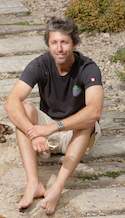A Johannesburg-based investment banker, Van der Spuy had been the first to plant vineyards on the spur of land that ends in Cape Point jutting out into the South Atlantic. Having started kaolin mining in the area in the 1990s, he'd seen the potential of the maritime climate for vines.

From 1996 he established three sites: sauvignon blanc, sémillon, and chardonnay on the mountain slopes above Noordhoek; cabernet sauvignon and shiraz on Redhill above Scarborough; and some cabernet sauvignon and merlot on a slope overlooking Sun Valley.
'As a winemaker, there's no particular grape I like working with; it's not about what the winemaker likes, it's about the site and the fruit it delivers. I'm just there to capture the flavours and character of the wine and get it into the bottle to be enjoyed.'
'You know, nature is strange. This spot, called Stonehaven, where we live and which Sybrand developed, also had vines growing here. But only in hindsight did we realise they should never have been planted here. We made the decision that they had to go: they were really scraggly, sick-looking plants, punished by the salty sea air and the constant wind, not suitable for producing premium wine.'
Under Duncan's guidance, the focus shifted from the original three sites to just the world-class Noordhoek vineyard. Cape Point, the home farm, now comprises some 22 hectares of vines, mostly sauvignon blanc, a couple of hectares of sernillon, and a smidgen of chardonnay.
'We're still quite young, but we’re cutting down our range quite drastically. This is it: Cape Point Vineyards Sauvignon Blanc, Sauvignon Blanc Reserve, Isliedh [named after Van der Spuy's first granddaughter], and Chardonnay. We may even cull the chardonnay, but people love it so we'll see...'
Duncan Savage likes to keep things simple and straightforward in the cellar. 'I have an idea of what I want to make with the fruit I've got and that's what I look for: just the expression of what the fruit brings to the wine. It's all about the terroir, the site. If grapes are planted in the right place, like our sauvignon blanc, it's not hard for a winemaker to make great wine; the wine kind of makes itself.'
In 2007, Cape Point Vineyards was rated top producer at the Old Mutual Trophy Wine Show. It was also chosen as the inaugural Platter's South African Wines guide's Winery of the Year for the 2008 edition. The citation read that, not only was it for a hat trick of five-star ratings and consistently making 'delicious, exciting, site-revealing wines of stellar quality but doing so with 'enthusiasm, care, and a refreshing degree of modesty. That's Duncan Savage.
At the end of that year, he was inducted into the Guild, goofy-footing on the crest of a wave of international accolades in both the United Kingdom and the United States courtesy of top wine magazine ratings in Decanter, Wine Spectator, and The Wine Advocate.
Duncan Savage had previously spent a harvest in Pouilly-Fume and Sancerre and a month visiting top sauvignon blanc producers in Australia's Margaret River and New Zealand's South Island. He's since been to Chile, Argentina, and Germany and on several follow-up trips to France, expanding his knowledge of sauvignon blanc.
At the end of 2010, Cape Point Vineyards opened to visitors with a tasting room, and 2011 saw the opening of a picnic and function facility on the farm.
'People can come and just relax. It's such a beautiful spot. Our vineyards and dams are the main breeding site for the protected Western leopard toad. We thought we'd donate a precentage of proceeds from the sale of some fresh, upfront, easy-drinking wines for the younger, trendier market. We came up with a funky label and called it "Splattered Toad", just for fun, even though it's a really serious, worthwhile cause. People loved it: we upped production from 3 000 six-bottle cases in 2009 to 15 000 12-bottle cases in 2011.'
 Gourmet beef burger recipe by Duncan Savage served with oven-roasted rosemary potatoes and paired with Cape Point Sauvignon Blanc Reserve wi...
Gourmet beef burger recipe by Duncan Savage served with oven-roasted rosemary potatoes and paired with Cape Point Sauvignon Blanc Reserve wi... Peri-peri chicken recipe by cellar master Duncan Savage served with Serve couscous and paired with Cape Point Isliedh wine....
Peri-peri chicken recipe by cellar master Duncan Savage served with Serve couscous and paired with Cape Point Isliedh wine....